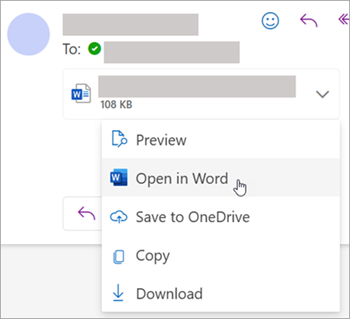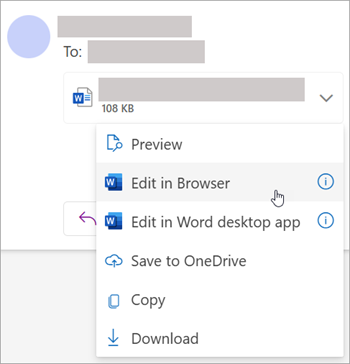Email messages that include attachments are identified by a paper clip 
Security Note: Outlook accepts a wide variety of different file types, but blocks potentially unsafe attachments (including .bat, .exe, .vbs, and .js files) that can contain viruses. Even with Outlook attachment protection, be careful in opening any attachment, especially if it’s from someone that you don’t know or trust. When in doubt, confirm the authenticity of the attachment with the sender. Also, keep your computer antivirus software up to date.
Select a tab option below for the version of Outlook you're using. What version of Outlook do I have?
Note: If the steps under this New Outlook tab don't work, you may not be using new Outlook for Windows yet. Select Classic Outlook and follow those steps instead.
Open attachments in new Outlook
Most of the time, you'll see attached files in the Reading Pane, directly under the message header or subject.
Single click or double-click the attached file to open it. Depending on if you're using a work or school account or a personal account, the file might open automatically in Preview or it will open in the file type app (such as Word, Excel, or PowerPoint.
Or select the dropdown and choose how to open based on the file type. For example, if it's a Word file, select Open in Word.

Save attachments in new Outlook
-
To save the attachment, click the dropdown arrow and select Download or Save to OneDrive.
Click Download to save one attachment to your computer or cloud storage location. Click Download all to save all attachments from a single message. -
Choose the folder where you want to save your file and select Save. The save location defaults to the last folder you saved a file to.
You can also save an attachment by dragging and dropping the attachment from your email message to your desktop.
Open attachments in classic Outlook
Most of the time, you'll see attached files in the Reading Pane, directly under the message header or subject. Occasionally, you'll see the attachments in the message body.
Double-click the attachment icon to open the attachment.
Save attachments in classic Outlook
To save the attachment, choose the drop-down arrow to the right of the attachment icon to open the attachment menu.
Choose Save As to save one attachment to your computer or cloud storage location. Choose Save All Attachments to save all attachments from a single message. By default, all of your attachments will be saved in your Documents folder, but you can choose a different location each time you save attachments.
You can also save an attachment by dragging and dropping the attachment from your email message to your desktop.
Open attachments in Outlook on the web or Outlook.com
Most of the time, you'll see attached files in the Reading Pane, directly under the message header or subject.
Single click or double-click the attached file to open it. Depending on if you're using a work or school account or a personal account, the file might open automatically in Preview or it will open in the file type app (such as Word, Excel, or PowerPoint.
Or select the dropdown of the attachment and choose how to open based on the file type. For example, if it's a Word file, select Edit in Browser or Edit in Word desktop app.

Save attachments
-
To save the attachment, choose the drop-down arrow and select Download or Save to OneDrive.
Click Download to save one attachment to your computer or cloud storage location. Click Download all to save all attachments from a single message. -
Choose the folder where you want to save your file and select Save. The save location defaults to the last folder you saved a file to.
You can also save an attachment by dragging and dropping the attachment from your email message to your desktop.
See Also
Preview attachments in Outlook










